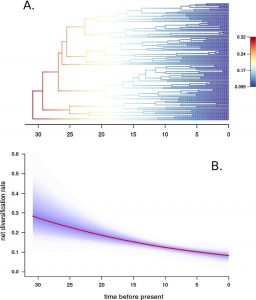 Widhelm T.J., F.R. Bertoletti, M.J. Asztalos, J.A. Mercado-Díaz, J.-P. Huang, B. Moncada, R. Lücking, N. Magain, E. Sérusiaux, B. Goffinet, N. Crouch, R. Mason-Gamer & H. T. Lumbsch. 2018. Oligocene origin and drivers of diversification in the genus Sticta (Lobariaceae, Ascomycota). Molecular Phylogenetics and Evolution 126: 58–73. pdf
Widhelm T.J., F.R. Bertoletti, M.J. Asztalos, J.A. Mercado-Díaz, J.-P. Huang, B. Moncada, R. Lücking, N. Magain, E. Sérusiaux, B. Goffinet, N. Crouch, R. Mason-Gamer & H. T. Lumbsch. 2018. Oligocene origin and drivers of diversification in the genus Sticta (Lobariaceae, Ascomycota). Molecular Phylogenetics and Evolution 126: 58–73. pdf
Abstract reads: A major challenge to evolutionary biologists is to understand how biodiversity is distributed through space and time and across the tree of life. Diversification of organisms is influenced by many factors that act at different times and geographic locations but it is still not clear which have a significant impact and how drivers interact. To study diversification, we chose the lichen genus Sticta, by sampling through most of the global range and producing a time tree. We estimate that Sticta originated about 30 million years ago, but biogoegraphic analysis was unclear in estimating the origin of the genus. Furthermore, we investigated the effect of dispersal ability finding that Sticta has a high dispersal rate, as collections from Hawaii showed that divergent lineages colonized the islands at least four times. Symbiont interactions were investigated using BiSSE to understand if green-algal or cyanobacterial symbiont interactions influenced diversification, only to find that the positive results were driven almost completely by Type I error. On the other hand, another BiSSE analysis found that an association with Andean tectonic activity increases the speciation rate of species.